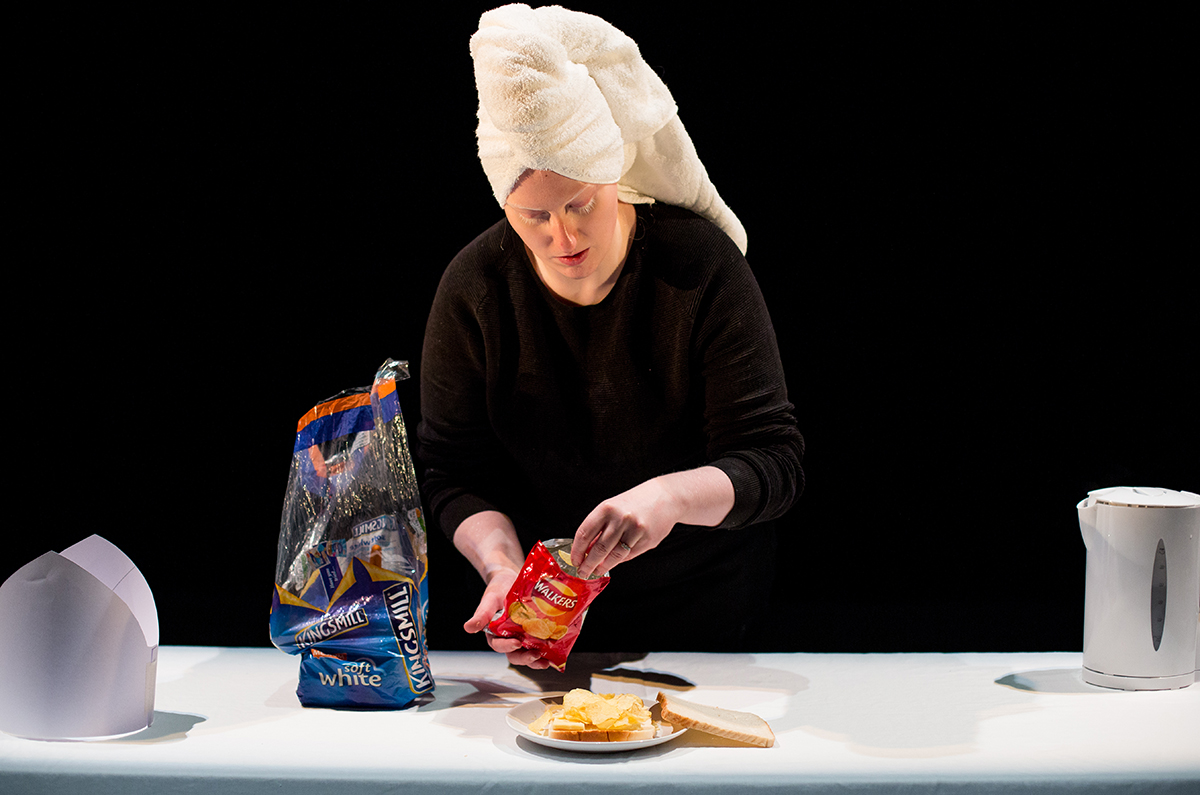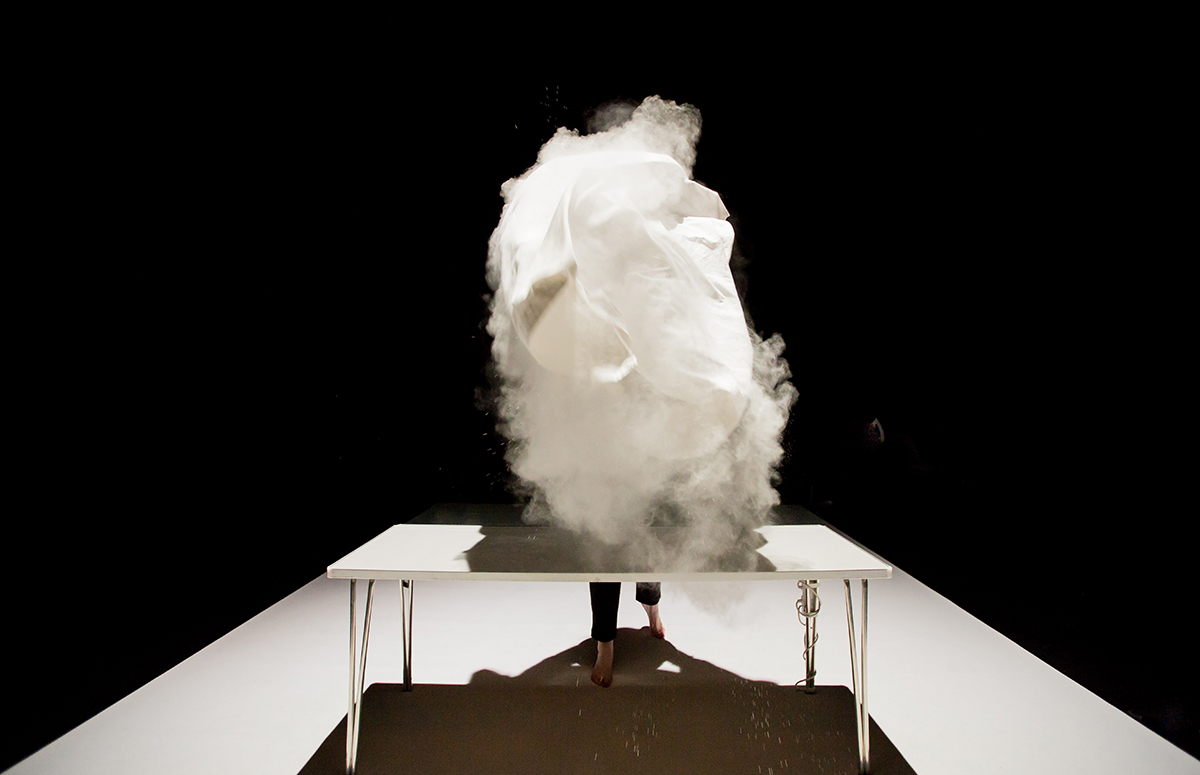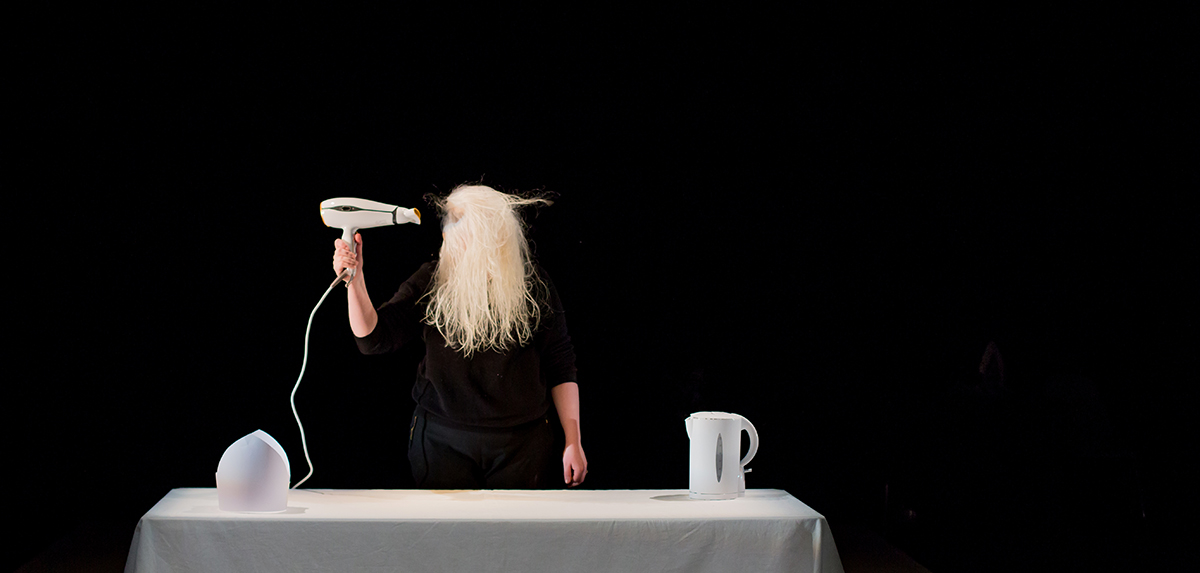
Interview: Jo Bannon, never a ghost
“Oh, hasn’t she got really, really, really bright hair.”
In Alba, performer Jo Bannon unfurls herself into a dark physical and imaginative space humming with hinted presences of ghosts, angels and monsters, cathedral vaults and the massed attention of the faithful, the intimate space between a mother and child and the snug refuge of a hiding place under a table. She holds the contradictions of the work within her body: ritual versus gentle humour, high drama versus mundane domesticity, her many small, careful movements versus her few wide and stylish declamatory gestures. She is luminous. So are her props: a piece of cloth, a kettle, an iron, a puff of dust.
“You and the Pope was coming together.”
Bannon’s birth coincided with the Pope’s visit to Coventry and her mother constructs a family story where both these events are part of the same miracle. In Alba, Bannon gently martials religious inducements to wonder, faith and spectacle into markers of her own physical and familial identity. She uses her mother’s voice retelling the birth and associated visit as the armature on which she builds her provocation, presenting her self and her bodily difference from within her own sensibility, making her world ours. By the end, we have spent 35 minutes watching a woman wash and dry her hair. It has been enthralling, shot through with a gleaming electric turbulence, and we are left shimmering in the afterglow.
A productive Q&A after the performance touched on investing the ordinary with myth; the white-bread comforts of a working class home; problematics of presenting whiteness as an issue in identity and bodily difference. The audience had felt, in the simplicity of what was visually presented on stage, that they had seen something elemental. Jo Bannon mentioned that even though light feels like the main language of the show, bright light is problematic for her and there is friction and difficulty in her experience of its beauty.
The following are Jo’s words from our subsequent interview.

Jo Bannon, Alba, photo Paul Blakemore
There was always this intention of humour in the work but I didn’t, I wasn’t, I hadn’t landed in the work because I hadn’t performed it enough, I didn’t know its scope. And it was much more tentative when it was performed for the first time. Space has a lot to do with it. When we do it in a big venue it looks really beautiful and it has this feel of being more meditative, more discursive. On the spectrum of one end being that high mass church, quiet and lofty; the other end is domestic, kitchen, Mum. When we’re in a small venue there’s much more of that world. In big venues it’s much more of the church world. And for me there’s always a thing in the work of trying to perform it, pitch it, so that it slips around those two modes. How often that happens I suppose is open to interpretation. For me the interest in the work is something that’s between mundane and miracle and can’t quite settle in one tone or the other.
If I think about how I move about in that piece there’s a few references and one is Child. Like doddering about with my Mum at home just idling time away, these kinds of quite ordinary things. And then the way you operate in a home, which is ‘oh I’ll just get that and then I’ll go and…’ You’re quite precise but you’re also taking your own time and there was a hope or a proposal in the work from me to myself which was to make a stage world that I felt I could inhabit. And maybe a provocation there of turning a black space white. And so when I perform the work, when I’m doing it well or when it’s clicking in for me, I do feel very much like this is my white world and I can take my time and move this and this will go exactly there. So I guess there’s a friction between doddering and exactness.
For me there’s something about creating magic or miracle: like when you see magicians they have to be absolutely precise — that kettle has to go there, otherwise that beam of light won’t hit the smoke and it will be nothing. You wait for five minutes for this kettle to be placed and boil and whatever. And something about the labour of that feels the same as this decision of my Mum’s to do the labour to tell the story and to tell the story and to tell the story and imbue it with this kind of meaning. There’s something hidden and magical (hopefully) in the way things appear like the smoke. But also you’ve watched every step that leads to that point.
Also the other thing about the doddering is, it’s a practical thing in that I was also interested in how my body, how albinism within my body affects how I am in the world and therefore on stage. And I do have really restricted vision. Okay, I don’t have a Scoobydoo sheet over me; I can see more than under a sheet. But there is a way that I move in the world that is often about touch and knowing how far things are. It’s a way I’ve learned to navigate and it’s kind of subconscious. I was interested in exploring that skill or ability. And so it doesn’t feel surprising to me that I end up bobbing about the stage under a sheet because it’s quite a natural way of being, in a weird way, for me, because of my less accurate vision.
The biographical work I’d made before was Exposure and that was the first quite delicate, tentative foray into how I look in and how I look out. I never mentioned the word ‘albinism’ in that work although it’s implicit within it. Maybe I’m interested in my Mum’s story because it’s her words, her description, of this experience. So it felt useful to kind of go into my identity and how that feels to have albinism through someone else’s story of it.

Jo Bannon, Alba, photo Paul Blakemore
I worked probably for a year, off and on, researching and sitting in studios and not really making anything on stage, just thinking and writing, and there were some images that kept coming up. One was this image of a head on the table with the hair in front and as the head rises the hair covers the face. I kept thinking about this and then I made this silly Pope mitre hat. So these kind of fragments of visions happened but I didn’t really know what it was, their sitting together, but I continually kept working with white objects. It’s funny when you make a process when you look back. I look back at the beginning, at little videos I took in studios or things in notebooks and it’s very clear; it’s almost like a description of what the work is now. But, of course, you don’t know that then, you have to go through this kind of circular journey.
I think I was always aware of fighting this interpretation of albinism — if looking in the media, for instance, for examples of people with albinism — or depictions of albinism like The Ghost, The Monster, The Alien, The Vampire; we get into The Bullied, The Victim; and we get into The Angel, The Savant, The Mystical. And there’s not room in any of that for the human.
I remember working in the studio and thinking I’m gonna put this sheet over me and do some hoovering. And film it and see. Really like, I think I’ve gone mad, I don’t know what I’m doing here; and that doesn’t happen in the show but I think there’s an echo of it somehow. To literally embody this idea of a ghost, with a white sheet over yourself but then do something that cuts against that, of something funny and normal and boring like hoovering. So yeah, it starts with weird fragments, things like that.
Then I was on a residency in Belgium and I went to this big cathedral and there was this huge High Mass with seven priests, it must have been some saint’s day or something. They were carrying these objects, books and bowls, all the things that are used in a mass. And there was this kind of click: these are some of the same objects that I’m using in the studio.
As soon as that idea came, in my mind it was like, ‘Oh, you’ve been making a Mass.’ Not, ‘I will make a Mass,’ but ‘That’s what these things are, that’s why they’re here.’ And then there’s quite conscious decisions about, well in that case, what we have to start with, Communion comes near the end, so the sandwich comes near the end. Then things get filled in. I find it really satisfying making it like a puzzle. Just keep waiting and waiting and waiting to see the picture, like you’re putting a jigsaw together and then suddenly you can see what it is.
–
Alba, Jo Bannon; toured by In Between Time; Arnolfini, Bristol, 8 Sept
Jo Bannon will give a keynote speech at the Australian Theatre Forum, 3 October, and will be hosting a two-week residency titled Performance and Penetration for artists at Access2Arts, 2-13 October. Both events are in Adelaide.
Top image credit: Jo Bannon, Alba, photo Paul Blakemore






